ToCoNet
 ToCoNet, developed by Tokyo Cosmos Electric based on the concept of "high performance and easy", is a relay network software in accordance with the global standard specification, IEEE802.15.4.
ToCoNet, developed by Tokyo Cosmos Electric based on the concept of "high performance and easy", is a relay network software in accordance with the global standard specification, IEEE802.15.4.
Developers can use the Software Development Environment (SDK) without restriction on functions and free of charge and license fee.
Vast amount of time and labor were necessary to understand and fully use the complex network specifications just for implementing simple wireless functions before. ToCoNet has been devloped to eliminate such a complexity and realize the environment where software development is done in a short period of time, we have developed the ToCoNet. We have selected and designed the necessary functions to satisfy "practical" requirements in typical wireless applications. ToCoNet supports star networks, tree networks and liner multi-hop networks.
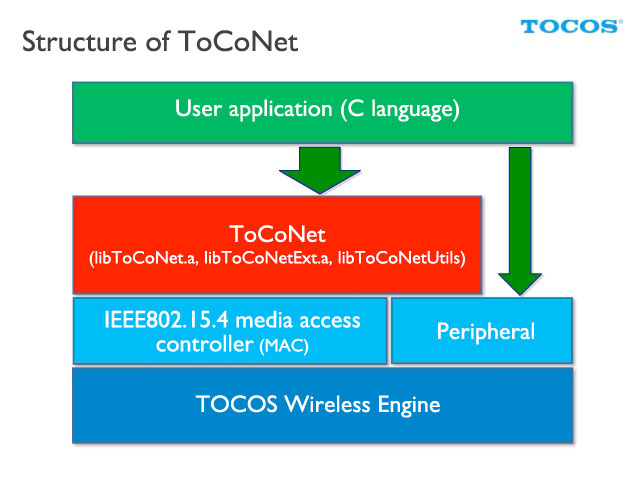
User application controls the wireless module through the ToCoNet library and peripheral API. ToCoNet libraries are divided into three sections.
- libToCoNet.a: definition of application loop, event processing, wireless network processing, etc.
- libToCoNetEx.a: start-up processing, interface to MAC layer, etc.
- libToCoNetUtils.a: general algorithm and peripheral procedures, etc. (source codes attached)
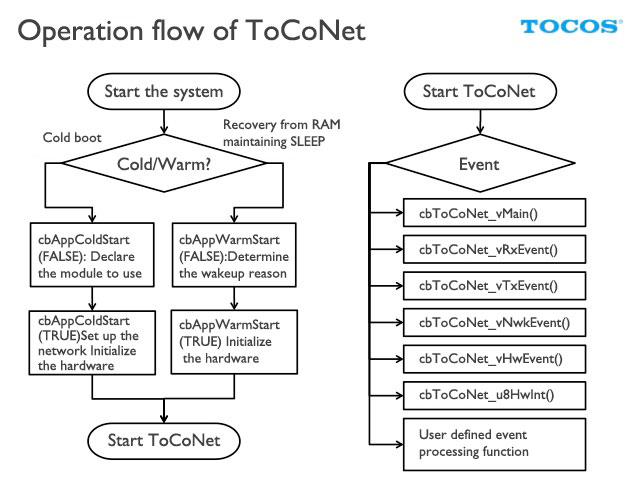
ToCoNet describes processing in some callback functions.
- cbAppColdStart(): Function to be called upon the power activation
- cbAppWarmStart(): Function to be called upon the sleep recovery
- cbToCoNet_vMain(): Main loop. This is not an infinite loop and is called upon the occurrence of interruption, etc.
- cbToCoNet_vRxEvent(): Called when wireless packets are received.
- cbToCoNet_vTxEvent(): Called when wireless packet sending is completed.
- cbToCoNet_vNwkEvent(): Notice of various events to the MAC layer and network layer.
- cbToCoNet_vHwEvent(): Implements delay for peripheral interruption processing. Called after the interruption processing.
- cbToCoNet_u8HwInt(): Peripheral interruption handler.
- User defined event processing function: Describes the task processing due to status transition.
All of these callback functions require returning of control after being called. If very long processing is described, it will affect all the behaviors. Particularly, it is necessary to pay attention to the interruption handler description.
*Wireless Engines to be newly shipped or attached to the Evaluation and Development Kit support ToCoNet; however, the single wireless engine products already purchased do not support ToCoNet. In this case, please contact us.
Issues for stack libraries
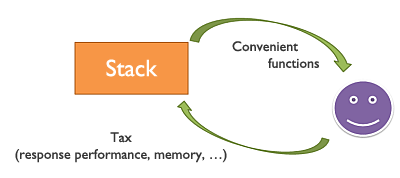 Stack libraries are indispensable for describing network applications that include repeater. Even when only one repeater is necessary, the implementation becomes extremely complex. For example, when one unit of repeater is installed, it may be easy if you can determine beforehand the repeater should communicate with which wireless station and conduct relay to which wireless station without changing the setting. However, if you use wireless transmission for this case, complex protocols will be necessary.
Stack libraries are indispensable for describing network applications that include repeater. Even when only one repeater is necessary, the implementation becomes extremely complex. For example, when one unit of repeater is installed, it may be easy if you can determine beforehand the repeater should communicate with which wireless station and conduct relay to which wireless station without changing the setting. However, if you use wireless transmission for this case, complex protocols will be necessary.
To provide advanced relay network function, a more complex implementation will be necessary. Mesh and other networks with highly free connection style need complex processing due to their own freeness, sacrificing the performance such as response time, number of units to connect, power consumption and stability. In the back side of the convenience obtained by the stack, restrictions associated with this do exist. Also, an ideal stack that can satisfy all the requirements of all the applications never exits.
By understanding the characteristics of IEEE802.15.4 and the needs for wireless from many customers and selecting the necessary functions, we have implemented the stack for ToCoNet to satisfy the application requirements more easily and in a shorter period of time.
Features of ToCoNet
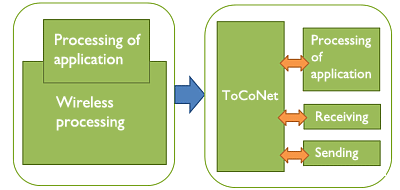 The purpose of ToCoNet is to realize the relay network in an easy manner and to separate the wireless processing from the application processing that becomes intricate as a result of implementation.
The purpose of ToCoNet is to realize the relay network in an easy manner and to separate the wireless processing from the application processing that becomes intricate as a result of implementation.
- Ability to easily describe the native application that can pursue performance
- Including UART processing and some other library codes
- Multiple-hop relay function
- Avoiding of interfere by the TOCOS channel agility
- Optimizing of memory used by the modular structure
- Supporting power saving application
- Supporting star-type application
Measures of ToCoNet against radio wave interference
Measures to prevent interference are necessary for securing stable wireless communications. Interference prevention algorithm has been implemented to the ToCoNet to utilize the feature of ToCoNet allowing 2.4 GHz band high-speed communications and continuous communications and to carry out more secure communications.
TOCOS channel agility
To maximize the feature of 2.4 GHZ band as described above, ToCoNet carries out transmission by using multiple channels. Under IEEE802.15.4, 16 channels can be simultaneously used for 2.4 GHz band. TOCOS channel agility is a system to strengthen the communication certainty by using multiple channels without fixing to one channel during transmission.
High-speed processing of the TOCOS Wireless Engine ensures the sufficiently practical response performance even when multiple channels are used.
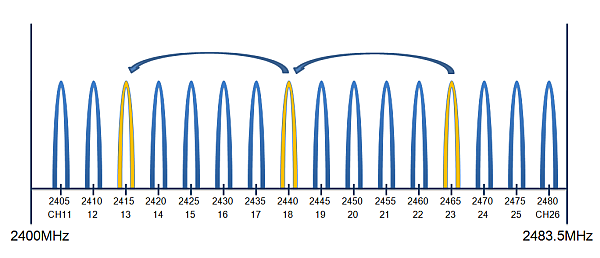
Security Function of ToCoNet
A robust security function is necessary for a safe wireless communications. ToCoNet supports strong encryption.
Encryption function
ToCoNet supports not only the AES-128 bit but also far stronger AES-256 bit encryption. High-speed processing by the TOCOS Wireless Engine operates a strong encryption algorithm.
Explanation on ToCoNet SDK
Wireless Products
- Overview
- Wireless Products Overview
- Wireless Engine
- TWE Lite DIP
- TWE-Lite
- TWE-REGULAR
- TWE-STRONG
- Software
- ToCoNet
- TWE-ZERO
- Evaluation, Development
- Evaluation & Development Kit
- Sensor Network Evaluation Kit
- Antenna
- Avaliable Antennae
Technical Information
- RFID
- 920MHz_vs_24
- IEEE802.15.4
- Protocol Stack
- ZigBee
- Wireless Sensor Networks
- Energy Harvesting Technology
- M2M Wireless Communications
- HEMS / BEMS / FEMS / CEMS
- Internet of Things

